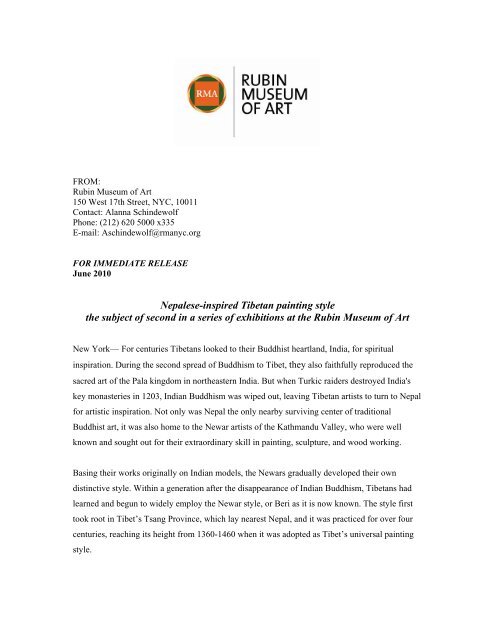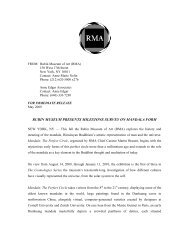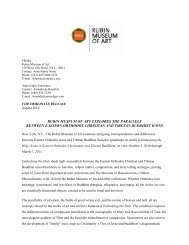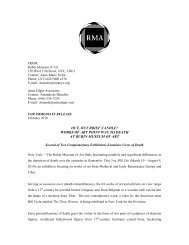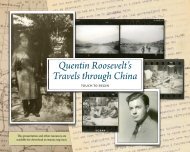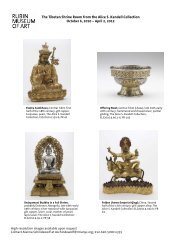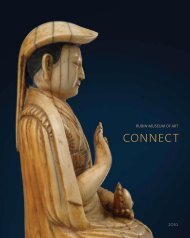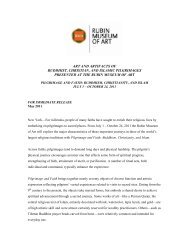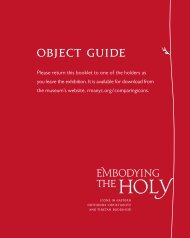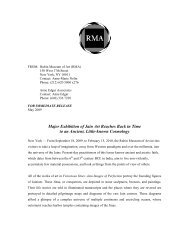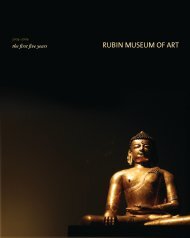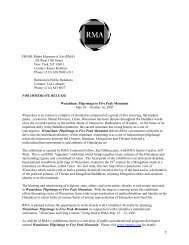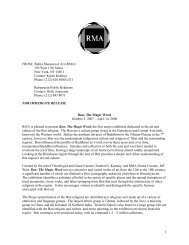The Nepalese Legacy in Tibetan Painting - Rubin Museum of Art
The Nepalese Legacy in Tibetan Painting - Rubin Museum of Art
The Nepalese Legacy in Tibetan Painting - Rubin Museum of Art
You also want an ePaper? Increase the reach of your titles
YUMPU automatically turns print PDFs into web optimized ePapers that Google loves.
FROM:Rub<strong>in</strong> <strong>Museum</strong> <strong>of</strong> <strong>Art</strong>150 West 17th Street, NYC, 10011Contact: Alanna Sch<strong>in</strong>dewolfPhone: (212) 620 5000 x335E-mail: Asch<strong>in</strong>dewolf@rmanyc.orgFOR IMMEDIATE RELEASEJune 2010<strong>Nepalese</strong>-<strong>in</strong>spired <strong>Tibetan</strong> pa<strong>in</strong>t<strong>in</strong>g stylethe subject <strong>of</strong> second <strong>in</strong> a series <strong>of</strong> exhibitions at the Rub<strong>in</strong> <strong>Museum</strong> <strong>of</strong> <strong>Art</strong>New York— For centuries <strong>Tibetan</strong>s looked to their Buddhist heartland, India, for spiritual<strong>in</strong>spiration. Dur<strong>in</strong>g the second spread <strong>of</strong> Buddhism to Tibet, they also faithfully reproduced thesacred art <strong>of</strong> the Pala k<strong>in</strong>gdom <strong>in</strong> northeastern India. But when Turkic raiders destroyed India'skey monasteries <strong>in</strong> 1203, Indian Buddhism was wiped out, leav<strong>in</strong>g <strong>Tibetan</strong> artists to turn to Nepalfor artistic <strong>in</strong>spiration. Not only was Nepal the only nearby surviv<strong>in</strong>g center <strong>of</strong> traditionalBuddhist art, it was also home to the Newar artists <strong>of</strong> the Kathmandu Valley, who were wellknown and sought out for their extraord<strong>in</strong>ary skill <strong>in</strong> pa<strong>in</strong>t<strong>in</strong>g, sculpture, and wood work<strong>in</strong>g.Bas<strong>in</strong>g their works orig<strong>in</strong>ally on Indian models, the Newars gradually developed their owndist<strong>in</strong>ctive style. With<strong>in</strong> a generation after the disappearance <strong>of</strong> Indian Buddhism, <strong>Tibetan</strong>s hadlearned and begun to widely employ the Newar style, or Beri as it is now known. <strong>The</strong> style firsttook root <strong>in</strong> Tibet’s Tsang Prov<strong>in</strong>ce, which lay nearest Nepal, and it was practiced for over fourcenturies, reach<strong>in</strong>g its height from 1360-1460 when it was adopted as Tibet’s universal pa<strong>in</strong>t<strong>in</strong>gstyle.
<strong>The</strong> <strong>Nepalese</strong> <strong>Legacy</strong> <strong>in</strong> <strong>Tibetan</strong> Pa<strong>in</strong>t<strong>in</strong>g marks the second <strong>in</strong> a series <strong>of</strong> exhibitions curated byDr. David Jackson that explore important <strong>Tibetan</strong> pa<strong>in</strong>t<strong>in</strong>g styles. In this presentation, Dr.Jackson traces the chronological development <strong>of</strong> the Beri style, highlight<strong>in</strong>g key artistic andstructural features. To the untra<strong>in</strong>ed eye, dist<strong>in</strong>guish<strong>in</strong>g Beri from other styles can provechalleng<strong>in</strong>g. To give basic stylistic orientation, he <strong>in</strong>troduces five key stylistic features that can befound repeatedly throughout the exhibition. To make the comparison easier, he pairs two Beripa<strong>in</strong>t<strong>in</strong>gs with pa<strong>in</strong>t<strong>in</strong>gs <strong>of</strong> the Pala style that share a common subject.Compar<strong>in</strong>g pa<strong>in</strong>t<strong>in</strong>gs side-by-side <strong>in</strong> this way, one beg<strong>in</strong>s to notice the Beri style’s dark <strong>in</strong>digoblue backgrounds, predom<strong>in</strong>ant red tones, simpler head nimbuses, decorative scrollwork, and th<strong>in</strong>yellow edges that act as outer borders and <strong>in</strong>ner divid<strong>in</strong>g strips between figures. Some subtler yettell<strong>in</strong>g trademarks <strong>of</strong> the Beri style <strong>in</strong>clude dist<strong>in</strong>ctive architectural details <strong>of</strong> throne backs,teardrop-shaped jewels that replaced those <strong>of</strong> sharper triangular or conical shapes common <strong>in</strong>Pala depictions <strong>of</strong> crowns, and even the lower robes <strong>of</strong> peaceful deities which are longer andcover their knees, unlike the bare knees and thighs characteristic <strong>of</strong> the Pala style.<strong>The</strong> <strong>Nepalese</strong> <strong>Legacy</strong> <strong>in</strong>cludes examples from each <strong>of</strong> the three ma<strong>in</strong> periods <strong>of</strong> Beri history:Early Beri (1180-1360), Beri as a Universal <strong>Tibetan</strong> Style (1360-1460), and Later Beri (1460-1620). Among the most notable works <strong>in</strong> <strong>The</strong> <strong>Nepalese</strong> <strong>Legacy</strong> is a masterful pa<strong>in</strong>t<strong>in</strong>g conta<strong>in</strong><strong>in</strong>gfour m<strong>in</strong>utely-detailed mandalas created by a group <strong>of</strong> Newari pa<strong>in</strong>ters who, <strong>in</strong> the mid-15 thcentury, decided to visit and work <strong>in</strong> Tibet at Ngor Monastery; the last two known majorcommissions <strong>in</strong> the Beri style; and important loans from the Walters <strong>Art</strong> <strong>Museum</strong>, the LosAngeles County <strong>Museum</strong> <strong>of</strong> <strong>Art</strong>, <strong>The</strong> Metropolitan <strong>Museum</strong> <strong>of</strong> <strong>Art</strong>, and a number <strong>of</strong> privatecollections.<strong>The</strong> exhibition concludes with a look at pa<strong>in</strong>t<strong>in</strong>gs commissioned by abbots <strong>of</strong> the legendarymonastery <strong>of</strong> Ngor Ewam Choden, one <strong>of</strong> the most famous sites <strong>of</strong> later Beri patronage <strong>in</strong> Tibet.<strong>The</strong> monastery was founded <strong>in</strong> 1429 by a great monastic reformer <strong>of</strong> the Sakya School namedNgorchen who, along with later abbots, commissioned many important works <strong>of</strong> religious art,particularly exceptional sets <strong>of</strong> Beri-style thangka pa<strong>in</strong>t<strong>in</strong>gs. Largely for this reason, many Berithangkas have been erroneously referred to as “Ngor pa<strong>in</strong>t<strong>in</strong>gs,” but evidence shows that similarworks were commissioned elsewhere. Late Beri pa<strong>in</strong>t<strong>in</strong>gs are more likely to be correctlyattributed to Ngor, as Ngor abbots rema<strong>in</strong>ed dedicated to the style as late as the second half <strong>of</strong> the16 th century, decades after most <strong>Tibetan</strong> artists had jo<strong>in</strong>ed the Ch<strong>in</strong>ese-<strong>in</strong>spired “landscaperevolution.” By the early 17 th century, the Beri style had virtually died out.2
Earlier scholars tended to overestimate the extent and duration <strong>of</strong> the Newar <strong>in</strong>fluence <strong>in</strong> <strong>Tibetan</strong>art while oversimplify<strong>in</strong>g the geographical range and sectarian scope <strong>of</strong> the Beri style. <strong>The</strong>sescholars tended to assume that the majority <strong>of</strong> Beri pa<strong>in</strong>t<strong>in</strong>gs were commissioned <strong>in</strong> Tsang by theSakya School <strong>of</strong> <strong>Tibetan</strong> Buddhism, and several important Beri works have hitherto beenmisidentified as Sakya art. In recent years scholars have begun to reexam<strong>in</strong>e pa<strong>in</strong>t<strong>in</strong>gs’<strong>in</strong>scriptions and l<strong>in</strong>eage details, rectify<strong>in</strong>g a number <strong>of</strong> misidentifications. In part, <strong>The</strong> <strong>Nepalese</strong><strong>Legacy</strong> seeks to correct the erroneous limitation <strong>of</strong> the Beri style to the Sakya School <strong>of</strong> <strong>Tibetan</strong>Buddhism, and to demonstrate the full extent <strong>of</strong> its chronological development, religiouspatronage, and geographic scope.<strong>The</strong> <strong>Nepalese</strong> <strong>Legacy</strong> <strong>in</strong> <strong>Tibetan</strong> Pa<strong>in</strong>t<strong>in</strong>g will be on view from September 3, 2010 – May 23,2011.Accompany<strong>in</strong>g Catalog<strong>The</strong> <strong>Nepalese</strong> <strong>Legacy</strong> <strong>in</strong> <strong>Tibetan</strong> Pa<strong>in</strong>t<strong>in</strong>g, the second <strong>in</strong> a series <strong>of</strong> full color exhibition catalogsby Dr. Jackson, will be available for purchase at the museum’s shop. Published by the Rub<strong>in</strong><strong>Museum</strong> <strong>of</strong> <strong>Art</strong>; 264 pages; $75.00 hardcover/$45.00 s<strong>of</strong>tcover.About the Rub<strong>in</strong> <strong>Museum</strong> <strong>of</strong> <strong>Art</strong>RMA holds one <strong>of</strong> the world’s most important collections <strong>of</strong> Himalayan art. Pa<strong>in</strong>t<strong>in</strong>gs, pictorialtextiles, and sculpture are drawn from cultures that touch upon the arc <strong>of</strong> mounta<strong>in</strong>s thatextends from Afghanistan <strong>in</strong> the northwest to Myanmar (Burma) <strong>in</strong> the southeast and <strong>in</strong>cludesTibet, Nepal, Mongolia, and Bhutan. <strong>The</strong> larger Himalayan cultural sphere, determ<strong>in</strong>ed bysignificant cultural exchange over millennia, <strong>in</strong>cludes Iran, India, Ch<strong>in</strong>a, Central Asia, andSoutheast Asia. This rich cultural legacy, largely unfamiliar to Western viewers, <strong>of</strong>fersan uncommon opportunity for visual adventure and aesthetic discovery.Admission to RMA is $10 for adults; $5 for seniors; $5 for students (with ID); free for seniorsthe first Monday <strong>of</strong> every month; and free for children under 12 and for museum members.Gallery admission is free to all on Fridays between 6pm and 10pm.Open Monday 11 am to 5 pm, Wednesday 11 am to 7 pm, Thursday 11 am to 5 pm, Friday 11 amto 10 pm, Saturday and Sunday from 11 am to 6 pm; closed on Tuesday. To reach the museum bysubway, visitors may take the A, C or E to 14th Street; the 1 to 18th Street; 1, 2, 3 to 14th Street;F and M to 14th Street; N, R, Q, 4, 5 and 6 to 14th or the L to 6th Avenue. By bus, visitors maytake the B20 to the corner <strong>of</strong> 7th Avenue and 17th Street.3


